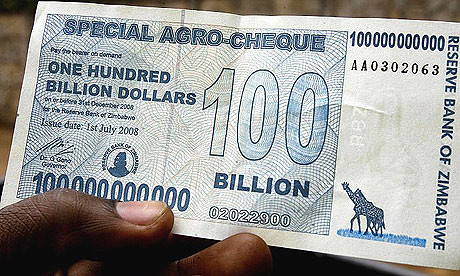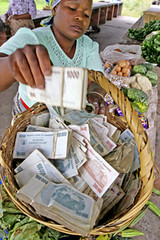
PREV ARTICLE
NEXT ARTICLE
FULL ISSUE
PREV FULL ISSUE
WHERE TO OBTAIN ZIMBABWE HYPERINFLATION BANKNOTESLast week Granvyl Hulse asked: I think that a $100 trillion Zimbabwe banknote would be quite a collector's item. Do you know of anyone selling them?  Above is an image of the $100 Billion note. Kerry Rogers reports that this dealer has examples of the $100 Trillion note in stock for $100, including shipping: www.worldcurrency.com One E-Sylum reader writes: I picked up a 100 billion note from Zimbabwe up at the NYINC show from the Educational Coin Co., for $5. They have it at their website, with quantity discounts. http://www.educationalcoin.com/detail.cfm?idnum=11255&ASSOC=B&showpic=yes Jon Radel writes: The really big notes of the current, 3rd ZW dollar, are still somewhat pricey, particularly the trillion dollar notes. As far as I can tell, only the 10 trillion note has actually been issued, though notes up through 100 trillion are to be phased in according to Dr. Gono, and photos have been released by the Reserve Bank of Zimbabwe. In the January 25 E-Sylum several questions came up about the current banknotes of Zimbabwe. Between the chaos in Zimbabwe and the general reticence by central banks and their printers to discuss contractual arrangements and technical details, there are many details which are uncertain, however, some details have been documented in the press and more have been subject to what appears to be informed speculation among observers in Harare. What is clear is that the Reserve Bank of Zimbabwe has a wholly owned subsidiary, Fidelity Printing and Refining Limited. As of July 1, 2008, as Giesecke and Devrient GmbH (G&D) pulled out of Zimbabwe, Newsweek [1] reported that G&D was printing about half the currency and supplying the security paper for the other half, presumably all used at Fidelity Printing, which was at that point running its equipment around the clock. I've seen little hint as to what equipment Fidelity Printing is using for the locally produced notes. In late July 2008 there were press reports out of South Africa and elsewhere that Jura JSP, an Austrian company, was supplying the Reserve Bank with licensed software for the design of banknotes. [2] The presses themselves appear to be German made, or at least that was the source of the spare parts the staff feared would no longer be available as of July 2008. [3] The quality of the paper used for all notes printed after the G&D paper ran out has been of lower quality, lacking watermarks and other security devices. To what extent this represents a lack of capability by the new supplier(s) and to what extent the Reserve Bank has simply decided to save money is unknown to me. Back in July 2008 the Reserve Bank announced that they were going to use a local paper supplier, though doubts were expressed given that they were already having trouble meeting current orders [3]. Since then, I've heard speculation that the paper is being imported from China, though my correspondent in Harare was unable to give me leads on documentation on that. Sometime soon, after more of the latest notes that are supposedly in transit to me actually arrive, I hope to analyze the actual characteristics of the notes. I'll offer my results to the editor. Meanwhile, one of the best sources for an organized listing of all the banknotes is the Wikipedia page. [4] As for where to buy the $100 trillion notes? That's a bit tricky. There are several sellers on eBay who will happily take your money (quite a lot of it, as a matter of fact, you can purchase a set of the 4 trillion dollar notes for USD 110 right now, and I've heard reports of prices as high as GBP 300), but it's unclear that they'll ever be able to deliver. While the $10, 20, 50, and 100 trillion notes have all been announced, only the $10 trillion was actually released on January 16. On January 29, I confirmed with my source in Harare that the 4 banks he deals with had been given no information on the release of the other 3 notes. Given that on January 29 controls on use of foreign currency were removed [5], it is quite possible that the local currency will completely collapse before more notes are issued. That said, eBay is the only source I've found for the latest notes. The normal channels for world banknotes really don't move fast enough; one of my favorite "conventional" suppliers is just now able to offer the last of the 2nd dollar notes, and that was many, many zeros ago. As a parting thought, this quote from Dr. Gono that the Reserve Bank has been running on their home page for some time now may help clarify everything: "I am pleased to report that the invisible forces of destruction have been unmasked marking a turning point chapter when the fraudulent and speculative winds are cast into the inferno of extinction." Anybody who knows more, do please share! [1] http://www.newsweek.com/id/144387/output/print [2] http://www.monstersandcritics.com/news/africa/news/article_1419212.php [3] http://articles.latimes.com/2008/jul/14/world/fg-money14 [4] http://en.wikipedia.org/wiki/Zimbabwe_banknotes [5] http://www.washingtonpost.com/wp-dyn/content/article/2009/01/29/AR2009012900855.html Don Cleveland forwarded an electronic newsletter from Steve Milner of the International Bank Note Society (IBNS). The Rhodesia—Zimbabwe Banknote Newsletter has just been launched - the issue is Number 1, January 2009. In it Steve writes: Welcome to this the first newsletter for the Rhodesia—Zimbabwe banknote collectors group. The banknote collecting “bug” hit me over 30 years ago when I lived in Rhodesia and took another quantum leap with the advent of the internet in the mid-nineties. Since then I have built up a reasonable collection and database of all the issues, date and signature varieties and so on. I have started this newsletter after I thought that it would be a good idea to share knowledge about the banknotes and paper currency of this troubled country. I am being asked questions by collectors from all over the world on a regular basis and a newsletter would be a good medium to share that knowledge. Hopefully the newsletter will become an educational tool for all of us to share. For more information, or to request a copy, contact Steve Milner at durham_111@yahoo.com.au Dick Hanscom noted that some notes are available on eBay as well. He also forwarded a link to this BBC news article and video which says that Zimbabwe is in effect abandoning its hyperinflated currency and allowing its citizens to conduct business in other currencies. -Editor  Zimbabweans will be allowed to conduct business in other currencies, alongside the Zimbabwe dollar, in an effort to stem the country's runaway inflation. Zimbabweans will be allowed to conduct business in other currencies, alongside the Zimbabwe dollar, in an effort to stem the country's runaway inflation. The announcement was made by acting Finance Minister Patrick Chinamasa. BBC southern Africa correspondent Peter Biles says the Zimbabwean dollar has become a laughing stock. A Z$100 trillion note was recently introduced. Until now only licensed businesses could accept foreign currencies, although it was common practice. "In line with the prevailing practices by the general public, [the] government is therefore allowing the use of multiple foreign currencies for business transactions alongside the Zimbabwean dollar," he said. The country is in the grip of world-record hyperinflation which has left the Zimbabwean dollar virtually worthless - 231,000,000% in July 2008, the most recent figure released. Teachers, doctors and civil servants have gone on strike complaining that their salaries - which equal trillions of Zimbabwean dollars - are not even enough to catch the bus to work each day. A Harare resident said even street vendors were refusing to accept Zimbabwean notes. Last year, the Central Bank was forced to slash 10 zeros from the local unit in an effort to make the currency more manageable. Correspondents say that although the local currency will still be printed, all prices will be set in US dollars, making the Zimbabwe dollar irrelevant. To read the complete article, see: Zimbabwe abandons its currency (news.bbc.co.uk/2/hi/africa/7859033.stm) Wayne Homren, Editor The Numismatic Bibliomania Society is a non-profit organization promoting numismatic literature. See our web site at coinbooks.org. To submit items for publication in The E-Sylum, write to the Editor at this address: whomren@gmail.com To subscribe go to: https://my.binhost.com/lists/listinfo/esylum All Rights Reserved. NBS Home Page Contact the NBS webmaster 
|